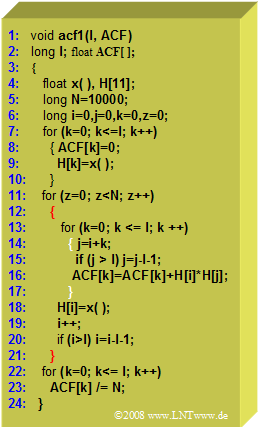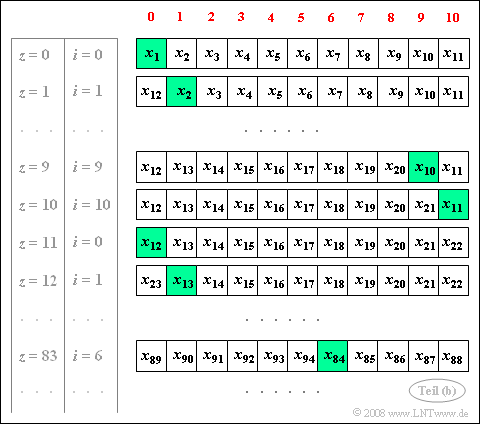Exercise 4.11: C Program "acf1"
From LNTwww
See the C–program "acf1" for calculating the discrete ACF values $\varphi_x(k)$ with index $k = 0$, ... , $l$. The following should be noted about this:
- The long–value passed to the program is $l = 10$. The ACF values $\varphi_x(0)$, ... , $\varphi_x(10)$ are returned to the calling program with the float field $\rm ACF\big[ \ \big]$. In lines 7 and 8 of the program given on the right, this field is pre-populated with zeros.
- The random variables $x_\nu$ to be analyzed are generated with the float function $x( \ )$, see line 4. This function is called a total of $N + l + 1 = 10011$ times $x_\nu$ (lines 9 and 18).
- In contrast to the algorithm given in the Theory section directly implemented in the program "acf2" of Task 4.11Z, one needs here an auxiliary field ${\rm H}\big[ \ \big]$ with only $l + 1 = 11$ memory elements.
- Before starting the actual calculation algorithm (lines 11 to 21), the eleven memory cells of ${\rm H}\big[ \ \big]$ contain the random values $x_1$, ... , $x_{11}$. The outer loop with the index $z$ (marked in red) is run $N$ times.
- In the inner loop (marked white) with the index $k = 0$, ... , $l$ all memory cells of the field ${\rm ACF}\big[\hspace{0.03cm} k \hspace{0.03cm} \big]$ are increased by the contribution $x_\nu \cdot x_{\nu+k}$.
- Finally, in lines 22 and 23, all ACF values are divided by the number $N$ of analyzed data.
Hint:
- This exercise belongs to the chapter Auto-Correlation Function.
- Reference is made in particular to the page Numerical ACF determination.
Questions
Solution
(1) With $z= 0$ and $k=6$ results according to the program: $\underline{i= 0}$ and $\underline{j= 6}$.
- The corresponding memory contents are ${\rm H}\big[\hspace{0.03cm} 0 \hspace{0.03cm}\big] = x_1$ and ${\rm H}\big[\hspace{0.03cm} 6 \hspace{0.03cm}\big] = x_7$.
(2) In the field ${\rm H}\big[\hspace{0.03cm} 0 \hspace{0.03cm}\big]$ the random variable $x_{12}$ is now entered:
- $$\text{memory cell }\underline{i= 0},\hspace{1cm}\text{sequence index }\underline{\nu= 12}.$$
(3) The graph shows the allocation of the auxiliary field with the random values $x_\nu$.
- In each case, the memory cell ${\rm H}\big[\hspace{0.03cm} i \hspace{0.03cm}\big]$ is highlighted in green. The new random variable is entered into this memory location at the end of each loop (line 18).
- For $z= 83$ and $K=6$ this results in
- $$\underline{i= 83 \hspace{-0.2cm}\mod \hspace{-0.15cm} \ 11 = 6},\hspace{1cm} \underline{j= (i+k)\hspace{-0.2cm}\mod \hspace{-0.15cm} \ 11 = 1}.$$
- Loop pass $z= 83$: In memory cell ${\rm H}\big[\hspace{0.03cm} 6 \hspace{0.03cm}\big]$ is the random variable $x_{84}$ and in the memory cell ${\rm H}\big[\hspace{0.03cm} 1 \hspace{0.03cm}\big]$ is the random variable $x_{90}$.
- At the end of loop pass $z= 83$ in ${\rm H}\big[\hspace{0.03cm} 6 \hspace{0.03cm}\big]$: The content $x_{84}$ is replaced by $x_{95}$ .

